ASUS' N82Jv: Jack-Of-All-Trades
by Jarred Walton on September 11, 2010 11:10 PM ESTASUS N82Jv-X2 General Performance
We've been through this before, and our test suite remains the same as in recent laptop reviews, so let's jump right in and see how the N82Jv fares. Two key matchups are highlighted in the charts: the M11x R2 that has the same GPU but a slower ULV CPU, and the Toshiba A660D that represents something of the high water mark for current AMD notebooks.
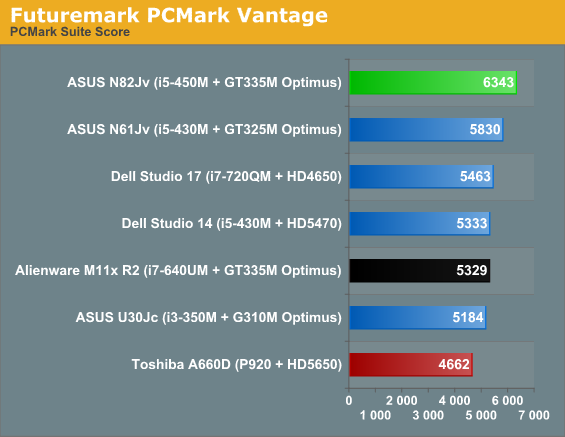
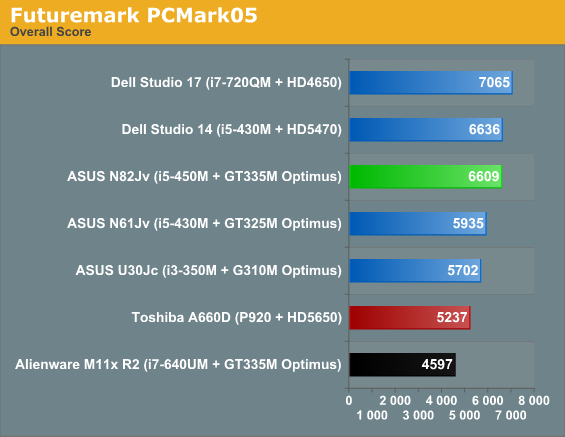
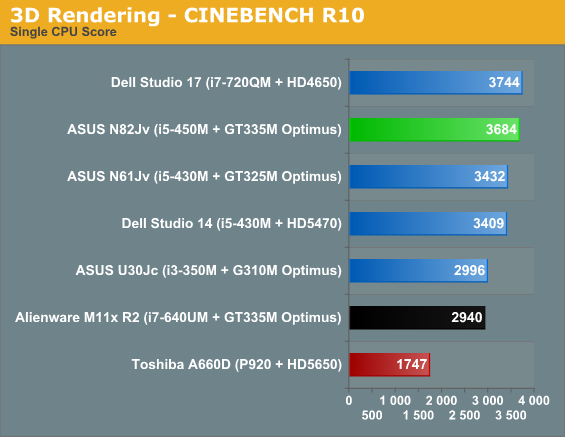

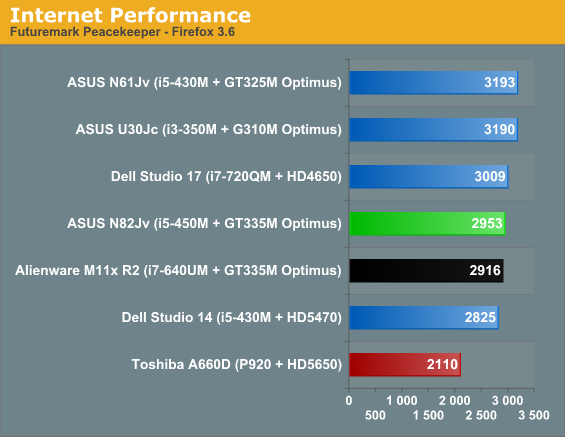
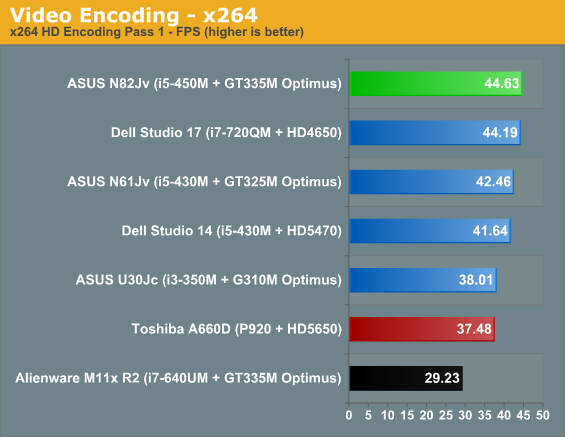
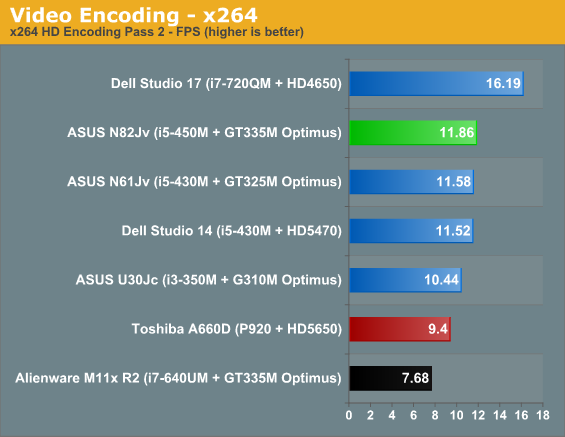
Right from the start, our two key comparisons show the N82Jv in a favorable light. Starting with the M11x R2, PCMark05 has the N82Jv leading the by 44%, while the Vantage result is "just" 19% higher. The close result of the M11x in Peacekeeper is an oddity…as is the loss to the slower clocked CPU/GPU of the N61Jv. It could be minor differences in the driver department, or perhaps the latest 3.6.8 Firefox updated reduced Peacekeeper performance. Regardless, we ran the test numerous times but the result was always lower than expected (and yet similar to the Studio 14). Peacekeeper is the exception to the rule, however. Cinebench gives the N82Jv a 25%/44% lead in the 1CPU/SMP tests, and the lead in x264 is just over 50% in both passes.
The comparison to the A660D leaves no question as to which processor is superior, with the lowest margin of victory coming at 20% in the first pass x264 encode—a test that's traditionally more HDD/bandwidth bound. PCMark has the N82Jv ahead by 36% in Vantage and 26% in 05, Peacekeeper gives the N82Jv a 40% lead, the single CPU Cinebench result is more than twice as fast as the P920, and the lead in multi-threaded tasks ranges from 20% to just over 30%. This is something we pointed out in the A660D review: when AMD's quad-core P920 can't come up with some clear wins over the i3-330M, it's a tough sell. Obviously, the i5-450M is faster than the 330M and simply increases Intel's lead; AMD's 2.0GHz N930 should come a lot closer to the Intel results in multi-threaded applications, but anything slower than that really needs to go after the value proposition.
Looking at the nearly identically equipped (outside of the GPU) Dell Studio 14, the N82Jv places about where we'd expect. The Vantage result favors ASUS by 19%, PCMark05 is a tie, but the remaining tests all give ASUS a lead of around 5% (give or take). It looks like ASUS has managed to better optimize the system performance, either with tighter memory timings, more BIOS tuning, or other tweaks. 5% is hardly anything to get worked up about, but it does show ASUS pays attention to some areas of performance more than many larger OEMs. $100 more for better performance, a significantly faster GPU, plus Optimus and USB 3.0 on top of that? Unless you can get the Studio 14 for a lot less than $900 for our tested system, the N82Jv is clearly a better choice.










33 Comments
View All Comments
Hrel - Sunday, September 12, 2010 - link
GPU = DX10. Simply foolish to buy that as we near 2011Screen resolution = 1366x768. Seriously?! When will they learn?
Just a personal thing, but I'd prefer a 15" laptop just cause I want a numpad.
Asus if you're reading this:
Screen resolution of 1600x900 or greater. (Preferably a contrast ratio of 500:1 or higher)
Battery size of 60Wh or greater. (Preferably 84Wh)
GPU = Nvidia DX11 with similar performance to the AMD HD5650.
CPU = Intel dual core w/ HT @2Ghz or greater with 3MB L3 cache or greater.
HDD = 7200rpm 320GB or greater. (500GB Seagate MomentusXT hyrbrid drive would be best.)
Don't price it over $1000. Go over to cyberpower.com, they build a similar system to this on a Compal whitebox for under 1K.
Hrel - Sunday, September 12, 2010 - link
you know, even if they stuck with the "standard" quality screen but upped the resolution I'd be happy. Just offer an upgrade to a better screen for 100 bucks or so. The batter can't give though, anything under 60Wh is ridiculous.Hrel - Sunday, September 12, 2010 - link
Just to clarify the GPU choice, I'm totally ok running games at 1280x720 on my laptop. High end all "eye candy" on gaming is what my desktop is for. That doesn't mean it's ok to make the screen low resolution. 1600x900 or higher or I won't even look at it.JarredWalton - Sunday, September 12, 2010 - link
Yeah, but you can't do 1600x900 gaming I think is the rationale. Or something. I got this laptop a couple weeks back, before the DX11 400M announcement, which arguably steals some of the thunder as well. I just really hope the inevitable update can give us the bigger battery, better screen, and at least a 435M. That would be a very sweet laptop, and it shouldn't be hard to take the N82Jv and make those tweaks in less than a month. Sell off the low-end screen in other models and make a nice "N82 Pro".kmmatney - Sunday, September 12, 2010 - link
The 16:9 display was the worst thing to ever happen to laptops...beginner99 - Sunday, September 12, 2010 - link
this.16:9 is bascially only useful for games and movies. for browsing or office work it's a pain in the ass. even 16:10 can be annoying for that.
teohhanhui - Wednesday, September 15, 2010 - link
I find 16:10 to be perfect for side-by-side comparison or just for viewing 2 pages of a document at a time.FH123 - Sunday, September 12, 2010 - link
Screen resolution = 1366x768. Seriously?! When will they learn?This comment scares me. Am I the only one who doesn't value resolution highly? I've used Windows 7 and still found plenty of software not fully optimised for high DPI, so I'd rather stick to the above resolution. I'd simply want a good display in that resolution.
I am the owner of a Thinkpad T410s with a 1440x900 display. Better, right? At least still 16:10? Wrong! Contrast ratio 95:1, black-level 2.9 cd/m2. I've no doubt the Asus' screen is crap, like Jarred says, but there's worse to be found in the high-end business segment. Basically I think I'd kill for the Asus' screen at twice the contrast and 1/3 the black-level!
synaesthetic - Sunday, September 12, 2010 - link
Windows 7 is designed for a minimum vertical pixel count of 768, so really, 1366x768 should only be present on laptops in the sub-13" size category.This is how I see it...
There's just no point in robbing yourself of more vertical pixels. And fix the "standard netbook resolution" of 1024x600 to actually be 16:10 instead of 16:9.4 or whatever it actually is.
1366x768 is a stupid resolution and deserves to go away.
10": 1024x640
11-12": 1280x800
13-14": 1600x900
15": 1600x900 or 1920x1200
16" and up: 1920x1200
Accept no substitutes.
synaesthetic - Sunday, September 12, 2010 - link
Correction: 15" should be 1680x1050 or 1920x1200 depending on preference. 1600x900 is the only good 16:9 resolution IMO, and it's pretty much perfect on a 14" panel.